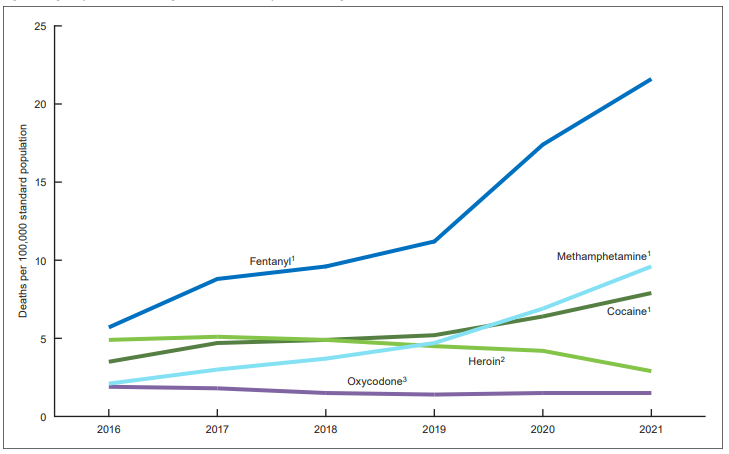CDC Study Shows Oxycodone Plays Minor Role in Overdose Crisis
/By Pat Anson, PNN Editor
A new study by the CDC highlights the sharply rising death toll in the U.S. caused by illicit fentanyl, while at the same time revealing the minor role played by oxycodone in the nation’s overdose crisis.
The study, released this week by the CDC’s National Center for Health Statistics, looked at overdose death rates from 2016 to 2021. Deaths involving fentanyl more than tripled during that period, rising from 5.7 deaths per 100,000 people in 2016 to 21.6 deaths per 100,000 in 2021. Drug deaths involving methamphetamine and cocaine also rose sharply, while fatal overdoses involving heroin declined.
And what about oxycodone, the most commonly prescribed opioid pain medication? It turns out oxycodone has always played a relatively minor role in the overdose crisis, although regulators and public health officials said otherwise in a concerted campaign against all prescription opioids.
“Overprescribing opioids – largely for chronic pain – is a key driver of America’s drug overdose epidemic,” then-CDC director Dr. Thomas Frieden said in a 2016 news release.
But the facts don’t support Frieden’s claim. In 2016, the year the CDC released its controversial opioid prescribing guideline, there were only 1.9 deaths per 100,000 people that involved oxycodone. By 2021, the rate had fallen 21% to 1.5 deaths -- well below the death rates of fentanyl, methamphetamine, cocaine and heroin.
Drug Overdose Deaths in U.S. (2016-2021)
SOURCE: CDC
CDC researchers used an unusual method to conduct this study. Instead of relying on medical ICD-10 codes in death certificates, which lump drugs together into broad categories, the CDC used a “literal text” analysis.
“To address the limitations of ICD–10- coded mortality data, the National Center for Health Statistics has developed a method that searches the literal text of death certificates to identify mentions of specific drugs and other substances involved in the death. Death certificate literal text is the written information provided by the medical certifier, usually a medical examiner or coroner for drug overdose deaths, that describes the causes, manner, and circumstances contributing to the death,” the researchers explained.
Flawed Data
The literal text method is not foolproof, but it’s an improvement over the ICD-10 codes, which the CDC admitted in 2018 “significantly inflate” the number of deaths involving prescription opioids — flawed data that Frieden used to make his “key driver” of the epidemic claim in 2016.
How inflated were the overdose numbers back then? Using the old ICD-10 method, which counted illicit fentanyl as a prescription opioid, Frieden’s CDC estimated that nearly 32,500 Americans died from overdoses of opioid medication in 2016. The death toll was later revised downward to about 17,000 overdoses after the CDC came clean about its flawed methodology.
Patient advocate Richard “Red” Lawhern has long been suspicious of CDC data, including studies that use literal text analysis.
“CDC suggests an incidence of drug overdose deaths ‘involving’ oxycodone at only 1.5 per 100,000. But they neatly avoid telling us that such a rate is so low that it confounds the non-uniformity of reporting from county to county, creating such statistical noise that the contribution of this agent (oxycodone) to overdose mortality is too small to accurately measure or report,” Lawhern said.
Another problem is the qualifications of county coroners and medical examiners varies. Some are elected to their positions without any medical training or experience. The death certificates they fill out usually don’t say if a prescription drug was obtained legally or illicitly, or what specific drug or combination of substances caused the death. That is determined later by a toxicology test. As a result, a drug may be “involved” in a death and be listed on the death certificate, but have little or nothing to do with someone’s demise.
“It is startling that CDC has so consistently and deliberately conspired to disguise the fact that oxycodone really isn't significant in drug overdose mortality, and probably never has been,” Lawhern told PNN.
Of course, every death is a tragedy in some way, regardless of the cause or substance involved. The graphic below helps bring oxycodone’s role into more context – comparing the five leading causes of death in 2021 to those involving fentanyl, oxycodone and the other drugs.
SOURCE: CDC
Despite the minor role played by oxycodone in 2021 deaths, efforts continue to restrict its availability. This year the Drug Enforcement Administration reduced the supply of oxycodone for the seventh consecutive year. Since their peak in 2013, DEA production quotas for oxycodone have fallen by 65 percent. The tightened supply has resulted in recent reports of oxycodone shortages and patients unable to get their prescriptions filled.
The DEA justifies the cuts by saying it is concerned about diversion and abuse, but the agency’s own data shows that less than one percent of legally prescribed oxycodone (0.3%) is diverted to someone it was not intended for.











